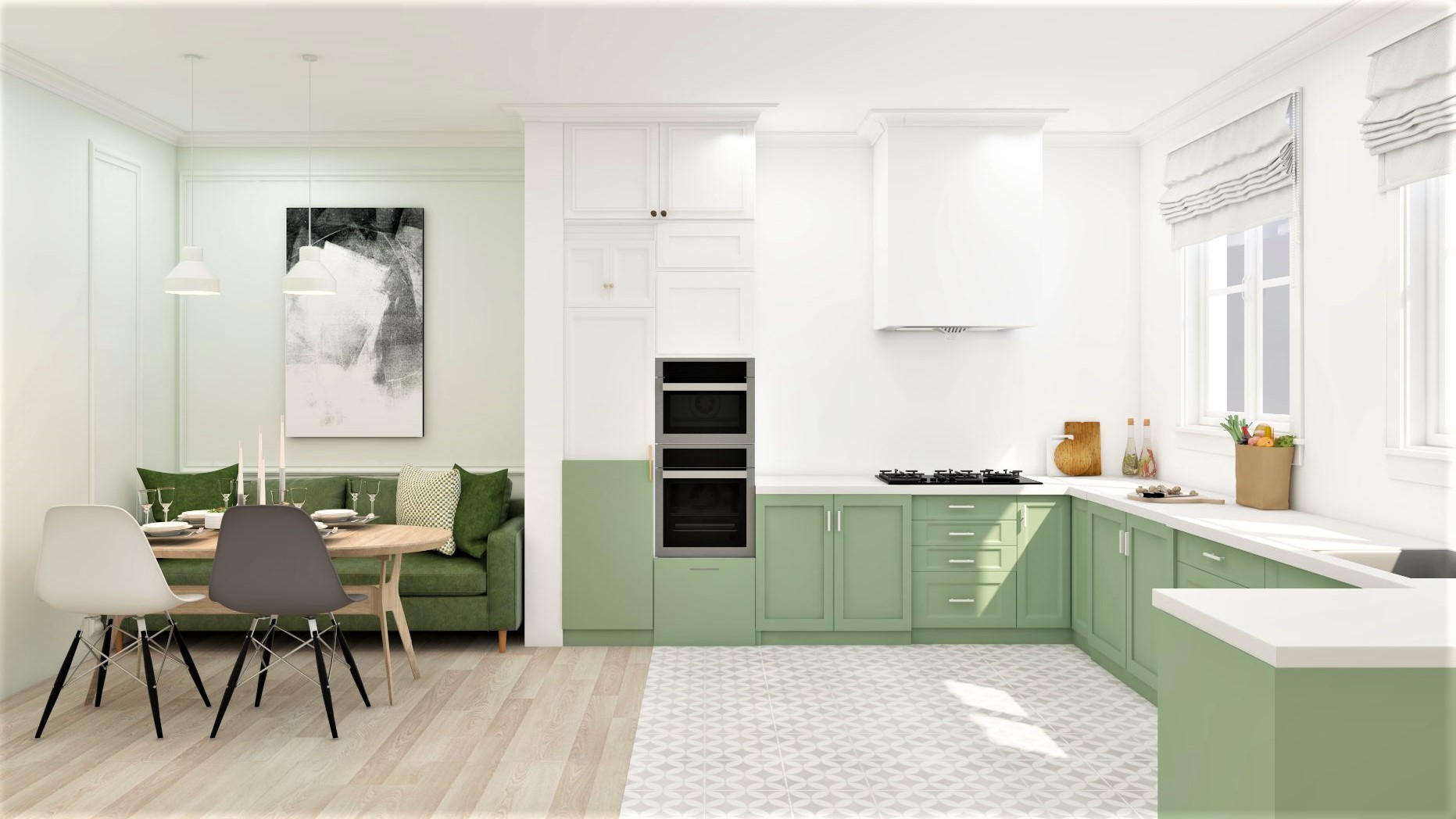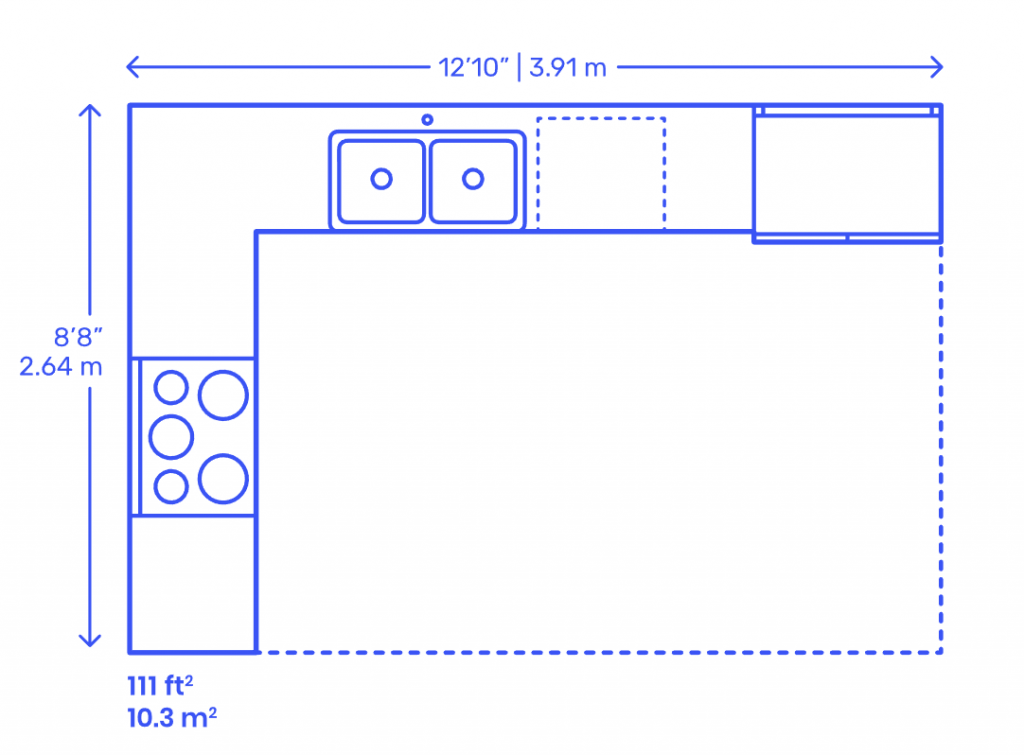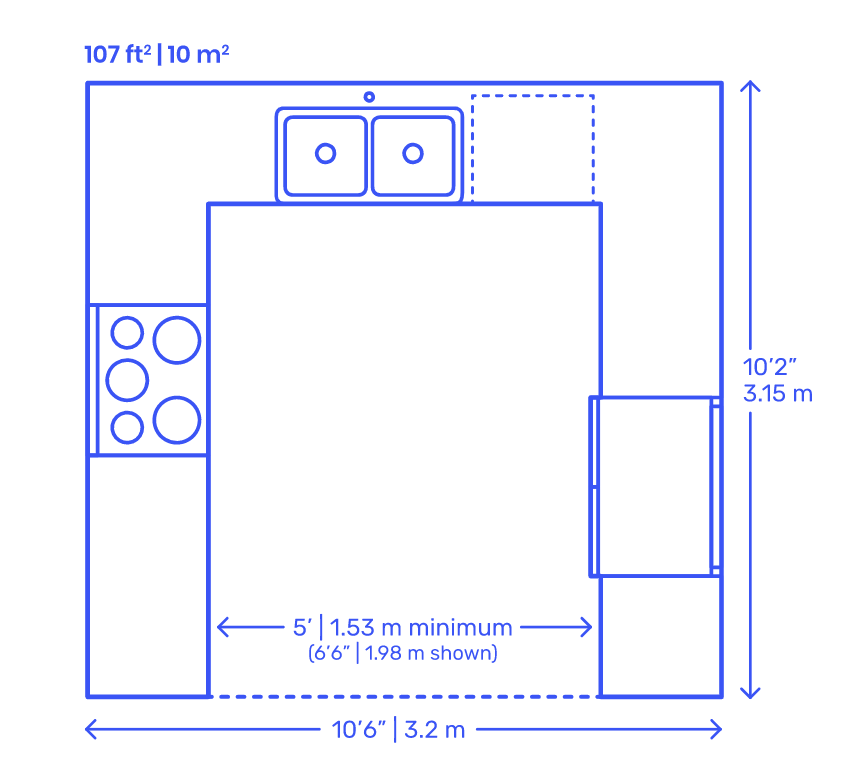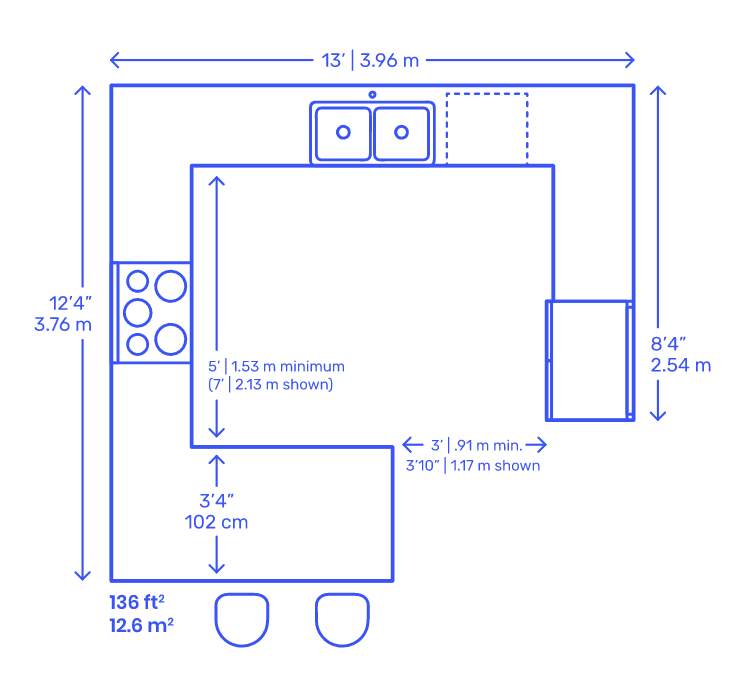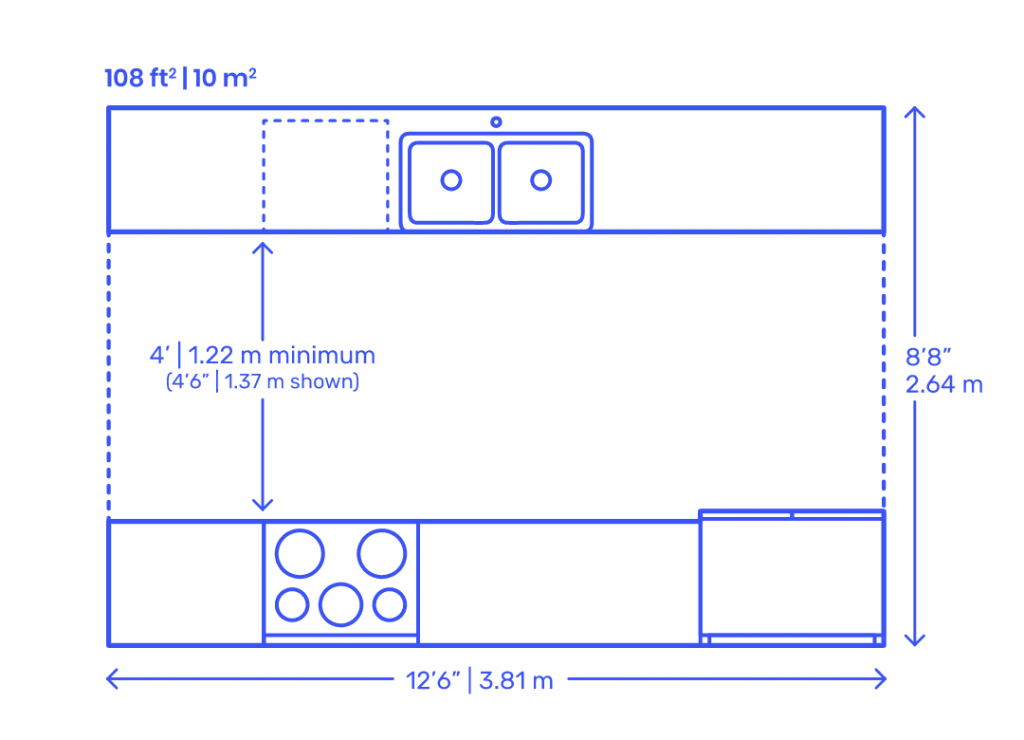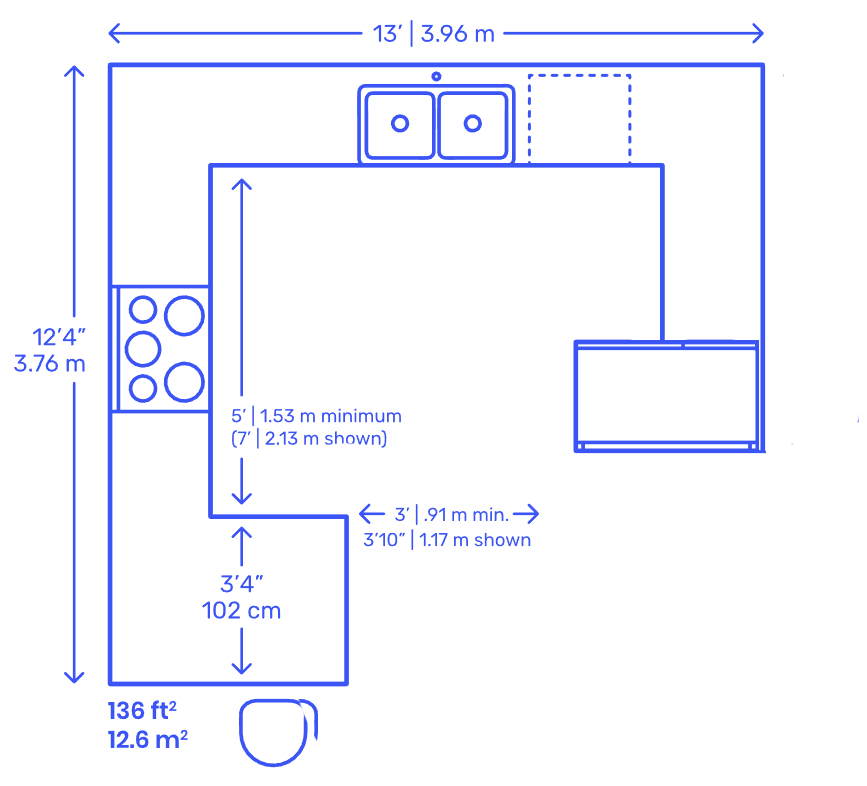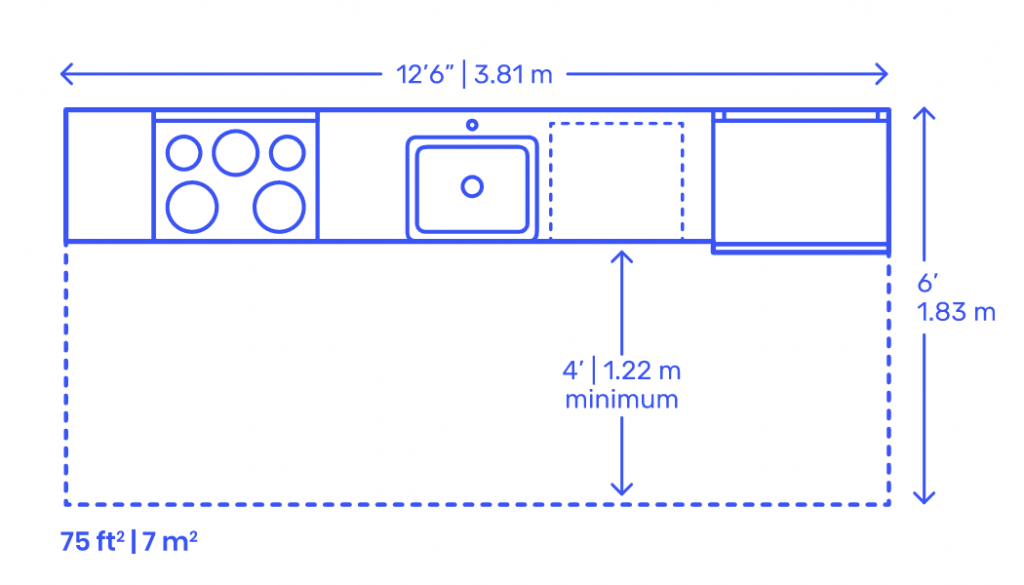Table of Contents
Kitchen Floor Plans
A kitchen is the heart of a home. Most homeowners want a state-of-the-art kitchen that still feels like home. Kitchen floor plans are essential blueprints that outline the layout and organization of a kitchen space, ensuring optimal functionality and flow. Using a kitchen planner tool can help determine the placement of key elements such as appliances, cabinets, countertops, and workspaces, creating an efficient cooking environment.
At Foyr, we specialize in designing kitchen floor plans that cater to your unique needs and preferences. Our advanced interior design software allows you to visualize your dream kitchen in 3D, making it easy to experiment with different layouts and styles. With Foyr, transforming your kitchen into a stunning and functional space has never been easier.
Read also – 6 Best Kitchen Layout Ideas For Small and Large Kitchen Design
How To Measure Your Kitchen Layout?
The start of a modern kitchen design or good kitchen remodels always begins with a clear view of the project. To conjure a practical kitchen design, the designer must accurately make use of every single square feet available. We have listed some critical pointers for you better measure any kitchen layout.
- You will first and foremost need a tape measure, graph paper, and a straight edge. This will help you accurately measure all the walls and surfaces and note down the measurements to scale on graph paper.
- While taking measurements, always tackle the kitchen in a clockwise direction. Number each wall, window, and door and note down their size.
- After measuring the lengths, it’s time to take note of all the heights. Note different measurements such as the floor to the windowsill, the windowsill to the top of the window, the top of the window to the ceiling, and finally, from the floor to the ceiling.
- You must draw or show a center line for all permanent fixtures such as hob, gas range, windows, sinks, closets, outlets, and ducts.
- Don’t forget to include the windows and door trim on the kitchen wall layout. The casing is a part of the window or door and should be considered in the overall measurement. The measurement should be taken from outside the trim to the middle of the door or window.
Read also – The Average Kitchen Size for All Types of Homes
Types of Kitchen Floor Plans with Dimensions
We have gathered the most common and popular options when it comes to a kitchen layout design. The choice is made according to several factors such as the size of the room available, the number of people who are going to use the kitchen, how frequently the kitchen will be used, etc.
1. L-shaped Kitchen Floor Plan with Dimensions
- An L-shaped kitchen consists of countertops on two adjoining walls forming a perpendicular L, which effectively maximizes corner space and is ideal for small to medium-sized kitchens.
- L-shaped layout enhances functionality by eliminating traffic, as it prevents the kitchen from becoming a thoroughfare and allows for the addition of dining space and multiple work zones.
- Often, one side of an L-shaped kitchen features the sink, while the stove is placed on the other side, with the refrigerator positioned on one side based on available length.
- L-shaped kitchen floor plans are particularly beneficial when they open to a dining or living room, creating a larger feeling between the two spaces due to the absence of barriers.
- The design typically offers flexibility in workstation placement and can accommodate additional features such as an island or small table for extra countertop space or seating, making it a popular choice for those considering a kitchen remodel. This layout is particularly beneficial in larger kitchens, where multiple cooking zones can be established, enhancing both functionality and the overall cooking experience.
Dimensions & Measurements
A clearance of 3’6″ (1.07 m) is mandatory in front of an L-Shape layout. The universally recommended widths start from 4’-6′ (1.2-1.8 m). The linear counters range from 3’-9′ (.9-2.7 m) on the short side and 8’-13′ (2.4-4 m) on the longer side. L-Shape Kitchens should ideally have an area of around 111 ft2 (10.3 m2).
Pros: This is one of the most cost-efficient and straightforward designs to execute. Adding an island counter can also compliment the functionality of the kitchen.
Cons: Depending on the user, some may find it agonizing to shuffle between the sink, stove, and refrigerator. Moreover, if more than two cooks are in the kitchen space, it can become too crowded to work efficiently in the small space. The corner base cabinets are also impractical unless you spend more on high-tech fittings that enhance their function.
Read also – What is Kitchen Triangle?
Image Credit: dimensions.com
2. U-shaped Kitchen Floor Plan with Dimensions
- The U-shaped kitchen layout offers continuous countertops and ample storage, effectively surrounding the cook on three sides for enhanced efficiency.
- This layout is versatile for both large and small kitchens, supporting multiple work zones for cooks to prepare meals simultaneously without feeling cramped, making the most of the available floor space.
- To enhance the functionality of a U-shaped kitchen, it is beneficial to conceal items like microwaves in cabinets and utilize corner storage solutions, such as a Lazy Susan.
- A well-designed U-shaped kitchen provides sufficient counter space, which is particularly advantageous for serious cooks engaged in extensive meal preparation or baking.
- Proper placement of appliances within the U-shaped layout is crucial; if they are too close together, it can lead to inefficiency and discomfort while working in the space.
Dimensions & Measurements
A clearance of 5′ (1.53 m) is mandatory in the center of a U-shaped kitchen. This zone can be maximized to have a space of 6’-8′ (1.8-2.4 m) to provide access and moving space for more than 2 people. The universally recommended width ranges between 9’-12′ (2.7-3.7 m).
The linear counters range from 3’-9′ (.9-2.7 m) on the short side and 8’-13′ (2.4-4 m) on the longer side. U-Shape Kitchens should have a footprint of around 107 ft2 (10 m2).
Pros: A chef can work smoothly with ample floor space. The design also offers an increased area for kitchen cabinets and counters on all three sides.
Cons: The U-shaped layout is very constricting and is not ideal for placing a table, Kitchen Island, or even breakfast chairs. Workstations can end up being too far from each other if not planned correctly. There is double wastage of space in terms of corner units as compared to an L-shaped kitchen.
Read also – 50 Best Kitchen Island Design Ideas
Image Credit: dimensions.com
3. G-shaped Kitchen Floor Plan with Dimensions
Peninsula kitchens or G-shaped kitchens are like U-shaped kitchens, but after running along three walls, they have a short bar counter extension at one end. They are known to offer additional seating space and extra workspace. They can easily contain multiple busybodies at any given time.
Dimensions & Measurements
A clearance of 5′ (1.53 m) is mandatory in the center of a Peninsula kitchen. This zone can be maximized to have a space of 6’-8′ (1.8-2.4 m) to provide access and moving space for more than 2 persons. A passage width of a minimum of 3′ (0.91 m) should be kept between the edge of the breakfast bar and adjacent cabinetry.
The universally recommended widths range between 13’-16′ (4-4.9 m). The depth of the counter ranges between 12’-15′ (3.7-4.6 m). Peninsula Kitchens should have an area of around 136 ft2 (12.6 m2).
Pros: Using all three sides gives ample cabinet space for storing food supplies and small appliances. Should you wish to embrace an open floor plan, you also have the option of knocking down a wall overlooking the living or the dining room.
Cons: The kitchen can feel slightly overwhelming due to the sheer extent of the cabinets built over the Peninsula. The corner spaces are often wasted or require additional storage fittings to work. Creating this style in a small area can restrict necessary movement for cooks and guests and make them feel cramped.
Read also – 80+ Beautiful Modern Kitchen Design Ideas
Image Credit: dimensions.com
4. Two-Row Galley Kitchen Floor Plan with Dimensions
A Two-row galley kitchen layout or the parallel kitchen is a wildly popular space-efficient system, perfect for small kitchens. They consist simply of two parallel counters fixed on opposite walls. Both counters are managed from a central access zone.
Dimensions & Measurements
A clearance of 4’-6′ (1.2-1.8 m) is mandatory between the two linear counters. The universally recommended lengths range between 7’-12.5′ (2.1-3.8 m). Parallel Kitchens should have an area of around 108 ft2 (10 m2).
Pros: The best part about a galley kitchen is that everything is within reach, making it one of the most functional layouts. It is an excellent proposition for tiny homes. They efficiently execute the work triangle system with designated work zones and maximized storage and shelving space.
Cons: They will have limited counter space compared to other kitchen layout ideas. It can also become slightly constricting, depending on the available width of the kitchen. It may be challenging for more than one person to use the kitchen simultaneously.
Read also – 20 Best Kitchen Backsplash Ideas
Image Credit: dimensions.com
5. P-shaped Kitchen Floor Plan with Dimensions
The P-shaped peninsula kitchen is the same as a traditional peninsula kitchen but follows the “P” shape rather than “G.” This style is best suited for large kitchens or open kitchen plans with more than enough space and work areas.
Dimensions & Measurements
A 5′ (1.53 m) clearance is mandatory in the center of a P-shaped kitchen. This zone can be maximized to have a space of 6’-8′ (1.8-2.4 m) to provide access and moving space for more than 2 persons. A passage width of a minimum of 3′ (0.91 m) should be kept between the edge of the breakfast bar and adjacent cabinetry.
The universally recommended widths range between 13’-16′ (4-4.9 m). The depth of the counter ranges between 12’-15′ (3.7-4.6 m). P-shaped Kitchens should have an area of around 136 ft2 (12.6 m2).
Pros: Additional workspace can be attained by adding a peninsula or an island. The kitchen triangle workflow is maintained impeccably. You can also convert your kitchen into a multi-purpose communal space by including a breakfast bar.
Cons: similar to the G-shaped kitchen, this style too can feel a bit clogged with the extensive use of cabinets on all three walls and above the island. Corner spaces are again underutilized unless you invest in blind corner cabinets.
Read also – 20 Best Kitchen Wall Decor Ideas
Image Credit: dimensions.com
6. One Wall Kitchen Floor Plan with Dimensions
This is a popular choice among tiny houses, studios and bachelor pads, where the kitchen is a part of the living room or the dining room.
- A single-wall kitchen layout is particularly well-suited for small homes, lofts, and efficient apartment kitchens, as it consolidates all appliances and workspaces against one wall.
- one-wall kitchen often features good traffic flow but is primarily designed for one cook at a time, making it less efficient for multiple users.
- The single-wall kitchen floor plan design incorporates a work line rather than a traditional triangle, with prep, cooking, and refrigeration zones located along a singular wall.
- To enhance functionality, additional storage can be achieved through stacking cabinetry or incorporating a kitchen island when space permits.
- one-wall kitchens are budget-friendly and maximize space efficiency, although they may require supplemental storage solutions like a separate pantry.
Dimensions & Measurements
A clearance of 4’-6′ (1.2-1.8 m) is mandatory in front of the counter. The universally recommended lengths range between 7’-12.5′ (2.1-3.8 m). Parallel Kitchens should have a footprint of around 75 ft2 (7 m2).
Pros: Considered to be highly efficient and cost-effective compared to other kitchen designs. If space permits, you also have the freedom to place an island or a table in front of the counter. This type of kitchen needs only one wall and is frequently seen in studio apartments with smaller kitchens.
Cons: Storage solutions must be planned meticulously, considering the minimum space availability. The lack of a work surface or kitchen table can also result in longer cooking times.
Read also – 10 Best Kitchen Remodeling Ideas
Image Credit: dimensions.com
7. Kitchen Island Kitchen Floor Plan with Dimensions
Kitchen islands are a common add-on that can be made to L, P, and U layouts. They are a chic addition to the kitchens.
- An island kitchen layout is most effective in an L-shaped kitchen with dimensions of at least 10×10 feet and should ideally be open to another area for better functionality.
- The average size of a kitchen island is 3 by 6.5 feet, requiring at least 42 inches of clearance for a comfortable walkway around it.
- Incorporating a cooktop or sink into the island can enhance its functionality, allowing for meal preparation and additional dining options.
- While islands add extra counter space and can serve as a buffet-style service area, they can disrupt the classic work triangle if not properly integrated into the kitchen design.
- Recommended spacing for a kitchen with an island includes 3.5 feet of circulation room between counter areas, which is especially crucial in a tight space, to ensure efficient movement and workflow.
Dimensions & Measurements
A clear space of 3’6″ (1.07 m) is required on all open sides of an island kitchen. The island can be placed along specific layouts, namely L-shape, G-shape, and U-shape.
Pros: Kitchen islands are a popular design idea that provides a different platform and counter space. They are often used as a breakfast bar or serving counter. Stylish bar stools further add to their splendour. By adding a stove top to it, it is also possible to exclusively reserve the island for food preparation.
Cons: One of the main issues with kitchen islands is that it’s hard to maintain an efficient exhaust system if you have a cooktop on the island. The hot surface can also be a peril for homes with children.
Read also – 28 Best Outdoor Kitchen Ideas and Designs
Image Credit: dimensions.com
Key Planning Factors
- The kitchen work triangle emphasizes the importance of positioning the refrigerator, stove, and sink within 4 to 9 feet of each other to enhance convenience and functionality.
- Efficient kitchen layouts should firmly establish clear zones for circulation, meal preparation, and cooking to facilitate smooth movement during tasks.
Utilizing the kitchen work triangle
- The kitchen work triangle is defined by the locations of the refrigerator, range or cooktop, and sink, and is essential for promoting kitchen efficiency.
- Each leg of the kitchen work triangle should ideally not exceed 26 feet to maintain a balance between accessibility and efficiency.
- Many kitchen layouts incorporate the work triangle to ensure that storage, prep, and cleaning areas are all within quick reach of each other for optimal functionality.
Understanding traffic patterns
- Understanding traffic patterns in the kitchen is essential to consider how both the primary cook and additional individuals, like family members or guests, will move around the space simultaneously, especially in relation to storage areas such as upper cabinets.
- A well-planned kitchen layout takes into account the impact of kitchen traffic on the effectiveness of cooking and food preparation, particularly when more than one person is using the space.
- Designing a kitchen with efficient traffic flow can help prevent the space from becoming overcrowded, allowing for better functionality when multiple users are present. Additionally, considering the color palette can enhance the overall ambiance and contribute to a more inviting atmosphere in a busy kitchen.
Maximizing counter space
- Adding an island to an L-Shaped kitchen layout can significantly increase countertop work surface and storage capacities, enhancing functionality.
- In a Galley kitchen layout, utilizing both walls for cabinets and a central walkway allows for efficient use of space, making it ideal for smaller areas.
- In both L-Shaped and U-Shape kitchens, well-planned arrangements create continuous work areas that improve efficiency and ease of access to cooking and prep zones.
- The P-Shape kitchen design extends an L-Shaped or U-Shaped layout with a peninsula, effectively adding extra work and storage space without consuming additional floor space.
Essential Design Tips
- The perfect kitchen layout takes into consideration the available space and desired functionality, ensuring that the design meets the users needs effectively.
- A well-designed kitchen work triangle, representing the flow between cooking, cleaning, and food storage, is crucial for an efficient kitchen layout.
- Popular and essential kitchen layout ideas include variations such as Island, L-Shape, U-Shape, Galley, Peninsula, and one-Wall kitchen, each serving specific spatial and functional requirements.
- Avoiding common kitchen floor plan mistakes, such as inefficient work flow and poor traffic patterns, is essential for creating a practical and enjoyable kitchen space.
Appliance placement
- When designing a kitchen layout, the island should be positioned to avoid blocking access to major appliances like wall ovens, dishwashers, and refrigerators.
- The placement of the sink is typically prioritized in kitchen layouts as it remains one of the most used fixtures, often influencing the design of the surrounding area.
- The kitchen work triangle, which includes the sink, refrigerator, and cooktop, plays a crucial role in optimizing the kitchen’s efficiency by minimizing distance and interruptions between these key pieces.
Smart storage solutions
- Storage walls can effectively combine pantry storage, small appliances, and other kitchen necessities in one convenient location, enhancing both functionality and aesthetics.
- Smart space planning allows for storage enhancements like pullout tower pantries or full pantries adjacent to galley kitchen designs, maximizing efficiency in small kitchens.
Enhancing usability
- A well-planned kitchen layout maximizes movement and minimizes the need to stop and reach, enhancing the overall functionality of the space.
- U-shaped kitchen designs offer continuous countertops and ample storage, surrounding the cook on three sides, which is ideal for creating multiple work zones.
- Galley kitchen layouts are efficient for smaller spaces, providing a central walkway with cabinets on either side that facilitate high-task activities such as food prep and storage.
- Adding features like concealed microwaves and storage solutions such as Lazy Susans in U-shaped kitchens can help keep countertops clutter-free and optimize usability.
- Utilizing natural light and strategic seating arrangements around kitchen islands can greatly enhance user experience, making the kitchen a more inviting space for cooking and socializing.
Creative Ideas for Kitchen Configurations
- A kitchen island can enhance social interaction by creating a welcoming arrangement for guests while providing additional prep space for cooking tasks.
- The G-Type or peninsula kitchen layout expands workspace and increases storage options by utilizing three sides of countertop space for various kitchen functions.
- The U-shaped kitchen layout, now often paired with an island, facilitates efficient traffic flow and accommodates multiple cooks working simultaneously.
- Planning a kitchen layout involves considering the work triangle, ensuring efficient movement between cooking, cleaning, and food storage areas for optimal workflow, helping you achieve your kitchen dreams.
Open floor plans
- Open floor plans facilitate seamless interaction between the kitchen and dining areas, allowing cooks to engage in conversations while preparing meals.
- Incorporating an open floor plan can create a more welcoming atmosphere by removing barriers and enhancing the perception of space.
- An open space design trend encourages the use of shared areas, often transforming formal dining rooms into multi-functional kitchen spaces.
- Placing the majority of appliances and storage along one wall in an open-plan kitchen maximizes efficiency and maintains a tidy appearance.
- L-shaped layouts are particularly well-suited for open floor plans, offering a cost-effective and efficient use of space while connecting to adjacent living areas.
Innovative cabinet layouts
- The G-type or peninsula kitchen layout offers a versatile arrangement that can expand workspace and enhance storage options with counters on three sides.
- Combining open shelving with classic cabinets allows for a balance between visually appealing decor and storage for functional cooking essentials.
- A well-planned kitchen cabinet layout is crucial as it determines the location of appliances, work zones, counter space, and potential seating areas, thereby affecting overall kitchen efficiency.
- Implementing a rolling ladder in a galley-style kitchen optimizes storage accessibility by allowing users to reach high cabinets more easily, tailoring the space for organization.
How Foyr Neo is the Best Software for Kitchen Floor Plan Design?
Most clients defer to their designers when choosing the perfect kitchen layout to comfortably fit their space and requirements. Maybe the kitchen is a little too small for the conventional structure. Or maybe, they need an open island kitchen to better address their social commitments.
Whatever the case, as a designer, it makes your job easier to demonstrate to your clients exactly how each option may or may not suit their needs. The solution lies in utilizing a powerful 3D rendering software like Foyr Neo.
The best part of using Foyr Neo as a kitchen floor plan designer is that you don’t need to know anything about 3d modeling. The learning curve is very user-friendly, and you can start achieving instant results with the click of a button.
You can create a 3D model of the existing space as per the measurements taken and make an accurate visualization of your proposed kitchen design.
You can choose to explore real-time renders for a life-like portrayal of your ideas. With the learning curve set so low, you can start achieving instant results with just a few clicks. Sign up for the 14-day free trial to get started today!








